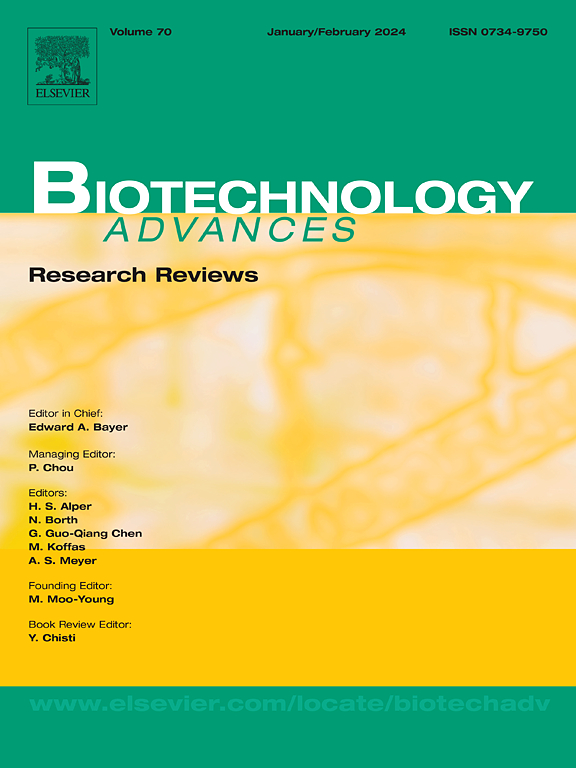聚乙烯(PE)生物降解的挑战-展望
IF 12.5
1区 工程技术
Q1 BIOTECHNOLOGY & APPLIED MICROBIOLOGY
引用次数: 0
摘要
PE给人们带来了便利,因为这种塑料便宜,而且有成千上万种不同的形式。由于PE具有高分子量和稳定的CC键,因此具有顽阻性。几十年来,人们一直致力于筛选从土壤、水、垃圾填埋场中分离出来的微生物,并辅以菌株收集中的微生物,以了解它们降解聚乙烯的潜力。然而,到目前为止,还没有令人信服的证据表明,在没有任何预处理的情况下,高分子量聚乙烯的生物降解。在这里,我们讨论了PE生物降解的潜在机制,特别是通过特异性或非特异性氧化反应激活c - c键。我们认为,任何酶都不可能在其高度氧化活性的一面接受非水溶性、高分子量的聚合物。因此,活性氧(ROS)可能是生物降解的关键步骤。研究氧化过程可能有助于解开PE(生物)降解之谜。在这种情况下,我们进一步认为,可靠的分析方法是必要的,包括稳定的,甚至可能是放射性同位素标记的聚合物,以避免模棱两可的实验结果。本文章由计算机程序翻译,如有差异,请以英文原文为准。
Challenges of polyethylene (PE) biodegradation – A perspective
PE brings convenience to people, as this plastic is cheap and performs in thousands of different forms. As PE with its high molecular weight and its stable C![]() C bonds is recalcitrant. For decades, much work has been dedicated to screening microorganisms isolated from, e.g., soil, water, landfills, complemented with microbes from strain collections for their potential to degrade PE. However, no convincing evidence of the biodegradation of high molecular weight PE, without any pretreatment, has been presented so far. Here, we discuss potential mechanisms of PE biodegradation, especially the activation of the C-C-bond by specific or non-specific oxygenation reactions. We argue that it is doubtful that any enzyme can accept a non-water soluble, high molecular weight polymer in its highly oxidative active side. Hence, reactive oxygen species (ROS) could be a critical step toward biodegradation. Investigating the process of oxygenation may help to unravel the mystery of PE (bio)degradation. In this context, we further argue that reliable analytical methods are necessary, including stable and maybe even radioactive isotope-labelled polymers, to avoid ambiguous experimental results.
C bonds is recalcitrant. For decades, much work has been dedicated to screening microorganisms isolated from, e.g., soil, water, landfills, complemented with microbes from strain collections for their potential to degrade PE. However, no convincing evidence of the biodegradation of high molecular weight PE, without any pretreatment, has been presented so far. Here, we discuss potential mechanisms of PE biodegradation, especially the activation of the C-C-bond by specific or non-specific oxygenation reactions. We argue that it is doubtful that any enzyme can accept a non-water soluble, high molecular weight polymer in its highly oxidative active side. Hence, reactive oxygen species (ROS) could be a critical step toward biodegradation. Investigating the process of oxygenation may help to unravel the mystery of PE (bio)degradation. In this context, we further argue that reliable analytical methods are necessary, including stable and maybe even radioactive isotope-labelled polymers, to avoid ambiguous experimental results.
求助全文
通过发布文献求助,成功后即可免费获取论文全文。
去求助
来源期刊

Biotechnology advances
工程技术-生物工程与应用微生物
CiteScore
25.50
自引率
2.50%
发文量
167
审稿时长
37 days
期刊介绍:
Biotechnology Advances is a comprehensive review journal that covers all aspects of the multidisciplinary field of biotechnology. The journal focuses on biotechnology principles and their applications in various industries, agriculture, medicine, environmental concerns, and regulatory issues. It publishes authoritative articles that highlight current developments and future trends in the field of biotechnology. The journal invites submissions of manuscripts that are relevant and appropriate. It targets a wide audience, including scientists, engineers, students, instructors, researchers, practitioners, managers, governments, and other stakeholders in the field. Additionally, special issues are published based on selected presentations from recent relevant conferences in collaboration with the organizations hosting those conferences.
 求助内容:
求助内容: 应助结果提醒方式:
应助结果提醒方式:


